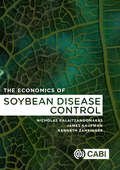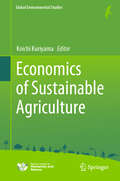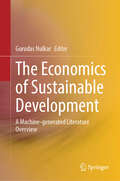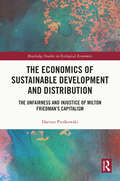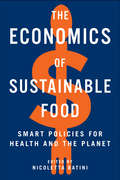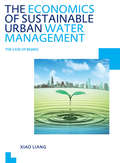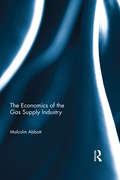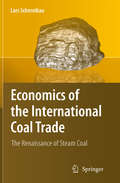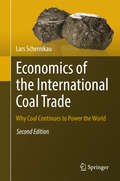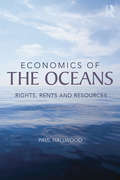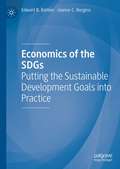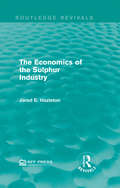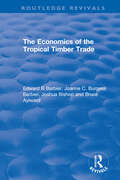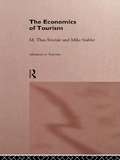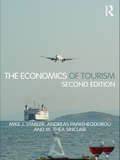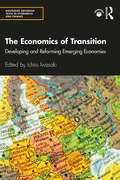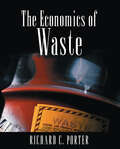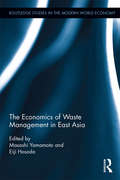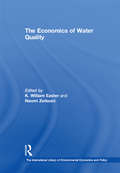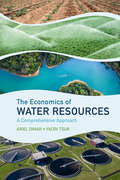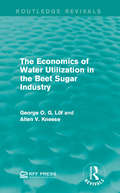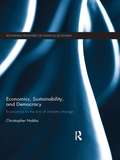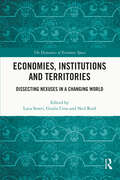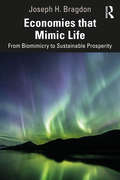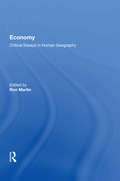- Table View
- List View
The Economics of Soybean Disease Control
by Nicholas Kalaitzandonakes James Kaufman Kenneth ZahringerWorldwide soybean crop yields can achieve USD$130 billion per year in farm-level sales, but around 13% of these yields are lost to disease. Effective disease management could generate significant economic benefits, and while disease management strategies do exist, their application remains limited among producers, often due to an incomplete understanding of disease incidence and severity, as well as perceived complexities of these strategies and a lack of information regarding success rates. This book presents an economic perspective on disease control, with an emphasis on producer choice among alternative technologies and potential changes in cropping systems. It provides an overview of global soybean diseases, their economic significance and management, and covers farm-level decision making, economic payoffs of alternative disease practices and key uncertainties. The book also outlines a global economic model that evaluates disease distribution and management implications. Key features include: - Extensive empirical case studies of soybean disease control, offering strategies for economically optimal management of diseases such as soybean seedling disease and root rot. - Analysis of economic factors to guide farm-level decision making. - Consideration of new technologies in disease management and their potential market-level impacts. This text is recommended for students and researchers in plant pathology and agricultural economics, as well as professionals in the soybean production industry.
Economics of Sustainable Agriculture (Global Environmental Studies)
by Koichi KuriyamaFertilizers are indispensable for agricultural production. Chemical fertilizers have significantly improved agricultural productivity. However, the excessive use of fertilizers has caused serious nitrogen pollution. What is the reason of a lack of progress in addressing nitrogen pollution? What is necessary to achieve sustainable nitrogen use in agriculture? This book provides a new perspective from an economic standpoint on these questions. Firstly, we propose the non-market valuation methods to evaluate the social costs of nitrogen. Because nitrogen control requires considerable effort and cost, evaluating the costs and benefits of nitrogen measures in monetary terms allows for a comparison of the expenses and benefits of nitrogen control, despite the delays in implementing such measures in the agricultural sector. Secondly, we analyze the behavioral changes of producers and consumers regarding nitrogen to indicate the direction of agricultural environmental policies for sustainable nitrogen use in the future. To achieve sustainable nitrogen use, farmers and consumers need to adopt production and consumption behaviors that consider nitrogen. By analyzing the effects of "visualizing" the nitrogen footprint on the behavioral changes of farmers and consumers, this book not only highlights the limitations of conventional agricultural policies but also provides recommendations for future agricultural environmental policies.
The Economics of Sustainable Development: A Machine-generated Literature Overview
by Gurudas NulkarThis book is a machine-generated literature overview that explores the interlinkages between communities, both rural and urban, and how they are dependent on natural resources and ecosystem services for livelihoods. With increasing urbanization and changing land use, sourcing food, fuel, and other basic needs from forests and grasslands is turning into a significant challenge, especially in the developing world where they have to balance regional aspirations against the environmental impact and legacy for forthcoming generations. As sources of sustainable livelihoods decline, it affects their ability to overcome poverty. Furthermore, economic impacts on the natural capital can undermine the long-term sustainability of communities, and negatively affect their health and well-being.To ensure economic growth and sustainable livelihoods, it is imperative to rethink how economic growth and agriculture can reduce their impacts on the natural environment. How dowe integrate economic, social, and environmental aspects into our economy? The book will discuss aspects of sustainable consumption, conservation of ecosystems and biodiversity, and making rural communities resilient to the impacts of climate change. By recognizing the economic value of ecosystem services, decision-makers can better understand the benefits and costs of different land uses and resource management practices and make more informed choices that promote sustainable livelihoods and natural capital conservation. The book will be a great resource for policy-makers, students of economics and sustainable development, non-governmental organizations working in this field, and corporate managers who are responsible for allotting budgets towards corporate social responsibility programs.^
The Economics of Sustainable Development and Distribution: The Unfairness and Injustice of Milton Friedman’s Capitalism (Routledge Studies in Ecological Economics)
by Dariusz PieńkowskiDrawing on a broad transdisciplinary background, this book compares distributive justice systems and related socioeconomic institutions within the liberal and sustainable development traditions. Confronting the capitalist worldview of prominent Nobel Prize–winning economist Milton Friedman, the book offers a theoretical framework for sustainable development: a new paradigm of economics grounded in environmental and social issues. The analysis takes as its starting point that the development and evolution of human beings is codetermined by socioeconomic institutions. These institutions facilitate models of society, morality and human behaviour: they are all social constructs. This matters because the liberal system of justice uses the claim that ‘life is unfair’ as the justification of socioeconomic inequalities, and it is these institutions which determine the concepts of fairness and justice. Therefore, the liberal system’s favouring of entrepreneurs should require advance measures to safeguard the interests of the losers—instead, it seeks to justify their misfortunes. It is argued that this liberal notion of fairness can only be fairly executed in conditions of perfect market competition, which have never existed. In contrast, the principles of sustainable development pay attention to the problems generated by the unjust and unfair distribution of resources and postulate wider use of the fairness formula ‘to each according to their needs’. It is thus more focused on fair ends than on fair procedures. This book is addressed to scholars and advanced students in ecological economics, environmental economics, economics of sustainable development and political science.
The Economics of Sustainable Food: Smart Policies for Health and the Planet
by Nicoletta BatiniProducing food industrially like we do today causes tremendous global economic losses in terms of malnutrition, diseases, and environmental degradation. But because the food industry does not bear those costs and the price tag for these losses does not show up at the grocery store, it is too often ignored by economists and policymakers.The Economics of Sustainable Food details the true cost of food for people and the planet. It illustrates how to transform our broken system, alleviating its severe financial and human burden. The key is smart macroeconomic policy that moves us toward methods that protect the environment like regenerative land and sea farming, low-impact urban farming, and alternative protein farming, and toward healthy diets. The book's multidisciplinary team of authors lay out detailed fiscal and trade policies, as well as structural reforms, to achieve those goals.
The Economics of Sustainable Urban Water Management: UNESCO-IHE PhD Thesis
by Xiao LiangRapid population growth, limited water availability, climate variability and environmental pollution together cause a significant challenge to provide sufficient water to urban residents in a sustainable and effective way. Advanced water treatment technology can contribute to the solution of problems physically, but it may not ensure sustainable op
The Economics of the Gas Supply Industry
by Malcolm AbbottIn recent years, natural gas has become a major source of energy, with trade across borders increasing through both pipelines and as Liquefied Natural Gas (LNG). Owing to this global development, this book traces the development of the gas supply industry, from localised to national industries and national industries to a major global industry. It looks at the basic economics and origins of the industry, as well as the role of the government in its development and relation to international markets. The book highlights certain economic characteristics such as the industry’s vertical and horizontal structure, the composition of consumer demand and the role of government in safety, planning and investment. With the understanding of the industry's long term development, the book helps to illustrate the relationship between natural gas producers and importers of LNG. This book would be of interest to scholars majoring in resource economics and energy economics, as well as to international practitioners in the natural gas market.
Economics of the International Coal Trade: The Renaissance of Steam Coal
by Lars SchernikauThe world today depends on oil, coal and gas (in that order of importance) for over 80% of its primary energy. From the time humans tamed fire, wood or bio-mass became the primary energy source. Coal took over from biomass during the Industrial Revolution and accounted for over 60% of world primary energy by the early 1900s. The current age is often referred to as the Oil Age, which seems appropriate now that about 35% of the world's primary energy still comes from oil. However, coal is experiencing a renaissance. Today about one quarter of the world's primary energy and more than 40% of the world's electricity comes from coal. In addition, about two thirds of the world's steel is produced using coal. The author predicts that coal will become even more important in the decades to come, mainly driven by demand from China and India. This book focuses on the role of coal for today's energy and, most importantly, electricity markets. It starts with a review of coal as a resource, profiling the major steam coal exporting nations and the structure of the supply market. The low investment rate in coal compared to other fossil fuels is discussed, and environmental and safety issues with coal production are reviewed. The book examines how coal is used in the modern world. It compares coal to other energy resources and speculates on a greater role for coal in the medium-term future. It examines the structure of the steam coal market, contract terms, derivative markets, FOB costs, and introduces the WorldCoal market model. The final chapter summarizes conclusions and predictions. The author predicts more and larger merger attempts in the coal supply arena and further efforts to manage this development through public policy, greater investment by market participants in logistics and upstream assets, and the development of exchange-based coal trading through standardized coal volumes. The author also outlines why he believes coal prices will rise, eventually catching up with gas.
Economics of the International Coal Trade
by Lars SchernikauCoal, the catalyst of the industrial age, is now poised to shape how the world consumes energy in the twenty-?rst century. The ascendance of oil in the global economy to a looming peak is forcing countries, companies, and consumers to reconsider their relationship to something they cannot live without: energy. And whileothersourcesofenergy, suchasnuclear, naturalgas, andrenewables, willall play an ever greater role in serving demand, intelligent observers would be wise not to miss what is perhaps the clearest trend of all: the second coal era is now uponus. Thedevelopingworldisrapidlyelectrifyinginordertodriveeconomicgrowth. Andelectri?cationmeanscoal. ThisisparticularlytrueinIndiaandChina, where coaloffersthecheapestandmostreliableroutetoelectricpower. Thesetwoco- triesalonewilldrive80%ofcoalconsumptiongrowthto2030. TheInternational EnergyAgencyexpectsthatglobalcoalconsumptionwillincreaseby60%inthe nexttwodecades. LarsSchernikau sTheRenaissanceofSteamCoalcouldnotcome atabettertime. Lars skillintracingthelongarcofindustrialevolutionpairedwith his acute knowledge of the coal market make his arguments both insightful and highlycredible. Hebeginsbysuccinctlyframingtheproblemanddistillingourc- rentpredicament: wearecaughtbetween theOilAge andthe theSolarAge (by thishemeanstheageofrenewables). Wearealloptimiststosomedegree, butthe realistsamongusknowthatrenewableenergyisnotgoingtocompletely?llthis gapfordecades. Where, then, doesthisleaveus?ItleavesuswithTheRenaissance ofSteamCoal. Coal is now the world s fastest growing source of fossil fuel, a position it is expected to hold for the foreseeable future. Yet the coal market is far less well understoodthantheoilorgasmarkets. Academics, policymakers, andmarketp- ticipantsarefacedwiththeprospectofourcollectiveknowledgeaboutthismarket notkeepingpacewithitsincreasingrelevance. Coal, only30yearsagoalocalized fuelsource, isnowavolatileglobalcommoditywithbanksandhedgefundspiling intotheoncetraditionalbusiness. Notonlyisthecoalmarketnowmorerelevant thanever, it salsomuchmorecomplex. "
Economics of the Oceans: Rights, Rents and Resources
by Paul HallwoodIt is an unfortunate truth that our oceans offer valuable resources that are too often used unsustainably. Time and again this is due to the failure of international law to provide a framework for adequate governance. Economics of the Oceans examines this issue and provides a comprehensive study of ocean uses from the perspectives of law and economics. Themes covered in the book include ocean governance, the economics of oceanic resource exploitation, offshore oil, coral reefs, shipwrecks and maritime piracy. Analytical techniques such as basic game theory, environmental economics of the commons and cost-benefit analysis are employed to illuminate the topics. This book will be of interest to students of environmental economics, natural resource economics and management, and the economics of international law as relating to the oceans.
Economics of the SDGs: Putting the Sustainable Development Goals into Practice
by Edward B. Barbier Joanne C. BurgessThis is the first book that employs economics to develop and apply an analytical framework for assessing progress towards the Sustainable Development Goals (SDGs). The authors explore the historical context for the underlying sustainability concept, develop an economics-based analytical framework for assessing progress towards the SDGs, and discuss the implications for sustainability policy and future research. Economics is concerned with analysing the trade-offs in allocating scarce means to achieve various ends. Thus, economic methods are ideally suited to assessing how progress towards one or more SDGs may come at the expense of achieving other goals. Such interactions are inevitable in meeting the 2030 Agenda over the next decade, given that the SDGs include different economic, social, and environmental elements. Although it may be possible to make progress across all 17 goals by 2030, it is more likely that improvement toward all goals will be mixed. For example, we may have reduced poverty or hunger over recent years, but the way in which this progress has been achieved – e.g. through economic expansion and industrial growth – may have come at the cost in achieving some environmental or social goals. On the other hand, progress in reducing poverty is likely to go hand-in-hand with other important goals, such as eliminating hunger, improving clean water and sanitation, and ensuring good health and well-being. Assessing these interactions is essential for guiding policy, so that countries and the international community can begin implementing the right set of environmental, social and economic policies to achieve more sustainable and inclusive global development.
The Economics of the Sulphur Industry (Routledge Revivals)
by Jared E. HazletonBetween the 1950’s and 1970’s, the Sulphur industry continued to grow despite occasional shortages and excesses. In this study originally published in 1970, Hazleton focuses on the Frasch sulphur industry to explore issues such as competing sources of sulphur, the possibilities of sulphur being obtained as a result of pollution-abating policies and the conditions under which future supplies are likely to become available. This title will be of interest to students of Environmental Studies.
The Economics of the Tropical Timber Trade (Routledge Revivals)
by Edward B Barbier Joanne C. Burgess Barbier Joshua Bishop Bruce AylwardOriginally published in 1994, The Economics of the Tropical Timber Trade provides a detailed analysis of the economic linkages between the trade and forest degradation. Based on a report prepared for the ITTO, it looks current and future market conditions at the time of publication, and assesses the impacts on current and future market conditions, and assesses the impacts on tropical forests of both the international timber trade and domestic demand. The authors examine the causes of deforestation and compare the environmental impacts of the timber trade with other factors, such as the conversion of the forests to agriculture. Finally, they assess the national and international trade policy options, and discuss the potential role of interventions in the international timber trade in promoting efficient and sustainable use of forest resources. The book will be of interest to those concerned with forest management and policy, trade and environment, and with the economics of conversation and resource use.
The Economics of Tourism (Routledge Advances In Tourism Ser.)
by M. Thea Sinclair Mike StablerMakes a key contribution from an economic standpoint to the understanding of tourism. Examining such issues as how tourism firms operate in national and global contexts, the effects of tourism on destination areas, the demand for tourism, and the interaction between tourism and natural environments, this comprehensive introduction explains how econ
The Economics of Tourism
by Mike J. Stabler Andreas Papatheodorou M. Thea SinclairThis new edition of The Economics of Tourism reflects the tremendous changes that have occurred in the tourism sector in the last twelve years. It recognizes that the nature of tourism demand and supply is being transformed by innovations in information communication technologies, market liberalization and climate change. Paralleling this, there is much greater interest in the study of tourism by both students and researchers in mainstream economics. The text is now in four parts covering: demand; supply; national, regional and international matters and environmental issues. The concluding chapter appraises the state of the economic research into tourism. The increased interest in tourism has engendered the development of new methods of analysis and the refinement of established ones. Accordingly, the book has been extensively restructured, revised and expanded with two new chapters: chapter six of the first edition is now broken down into two and a new chapter has been added on environmental issues to take account of new developments, critically review the associated literature and consider future trends in tourism economics research. The reader-friendliness of the book has also been enhanced in various ways, such as the extensive chapter cross-referencing to refresh the reader’s memory and the inclusion of a detailed list of abbreviations. The Economics of Tourism will continue to make accessible for the non-specialist, the application and relevance of economics to tourism. Extensively revised and updated, including research and case studies the textbook will be an indispensable resource for both students and researchers.
The Economics of Transition: Developing and Reforming Emerging Economies (Routledge Advanced Texts in Economics and Finance)
by Ichiro IwasakiIn the last three decades since the fall of the Berlin Wall, there has been a vast amount of study looking at transforming the planned economy to a market economy from both theoretical and empirical aspects. This book provides an overview and insight into transition economies in the recent decades and looks at key economics topics from the so-called “transition strategy debate” to environmental reform. The book also includes an analytical review and meta-analysis of the existing literature. By integrating theoretical discussions and synthesizing empirical findings in a systematic manner, this book may help to enlighten the debate on the timing, speed, and policy sequence of economic transition. The book will particularly appeal to researchers, policy makers, other practitioners, and under- and post-graduate students who are interested in transition economies in Eastern Europe, the former Soviet Union, Southeast Asia, and China. It aims to be read as an advanced reader.
The Economics of Waste (Rff Press Ser.)
by Richard C. PorterIn this concise, engaging, and provocative work, Richard Porter introduces readers to the economic tools that can be applied to problems involved in handling a diverse range of waste products from business and households. Emphasizing the impossibility of achieving a zero-risk environment, Porter focuses on the choices that apply in real world decisions about waste. Acknowledging that effective waste policy integrates knowledge from several disciplines, Porter focuses on the use of economic analysis to reveal the costs of different policies and therefore how much can be done to meet goals to protect human health and the environment. With abundant examples, he considers subjects such as landfills, incineration, and illegal disposal. He discusses the international trade in waste, the costs and benefits of recycling, and special topics such as hazardous materials, Superfund, and nuclear waste. While making clear his belief that not every form of waste presents the same amount of risk, Porter stresses the need for open-minded approaches to developing new policies. For students, policymakers, and general readers, he provides insight and accessibility to a subject that others might leave out-of-sight, out-of-mind, or buried under an impenetrable prose of statistics and jargon.
The Economics of Waste Management in East Asia (Routledge Studies in the Modern World Economy)
by Masashi Yamamoto Eiji HosodaThe existing literature provides very little information on the real and current process of waste disposal and recycling in China. China generates large amount of waste and it covers about 20 % of the world waste trade. This book focuses on China’s waste management and recycling policy. The book also examines the relationship between China’s waste management and recycling industry and its legal structure. It fills in the gap by providing insight into topics on how to resolve China’s waste management and recycling problems, theories and empirical studies on waste and management as well as waste management policies in East Asia. It also includes comparative analysis through case studies on other Asian countries such as Thailand and Japan.
The Economics of Water Quality (The International Library of Environmental Economics and Policy)
by Naomi ZeitouniThis volume brings together a number of prominent economic studies all of which deal with key water quality issues. The studies focus on the economic aspects of water quality including identifying the polluters' actions and incentives, designing and comparing control mechanisms, analyzing the costs and benefits of water quality programmes, and finally managing transboundary water quality. They all make recommendations for improving water quality through changing incentives, programmes and/or policies.
The Economics of Water Resources: A Comprehensive Approach (Natural Resource Management And Policy Ser. #24)
by Ariel Dinar Yacov TsurPopulation growth and rising living standards, on the one hand, and changing climate, on the other hand, have exacerbated water scarcity worldwide. To address this problem, policymakers need to take a wide view of the water economy – a complex structure involving environmental, social, economic, legal, and institutional aspects. A coherent water policy must look at the water economy as a whole and apply a comprehensive approach to policy interventions. Written by two of the world's leading scholars on economics of water, this is the first graduate-level textbook on the topic. The book discusses water resource management within a comprehensive framework that integrates the different, yet highly entwined, elements of a water economy. It follows the steps needed to develop a well-designed set of policies based on detailed analyses of intervention measures, using multi-sectoral and economy-wide examples from a variety of locations and situations around the world.
The Economics of Water Utilization in the Beet Sugar Industry (Routledge Revivals)
by Allen V. Kneese George O. LöfOriginally published in 1965, this case study of the beet sugar industry undertaken by George O. G. Lof and Allen V. Kneese illustrates the economic importance of water to industry. This study delves into the history and technology of the beet sugar industry to demonstrate the economic impact of the water environment and how water waste can be reduced in other industries. This title will be of interest to students of environmental studies.
Economics, Sustainability, and Democracy: Economics in the Era of Climate Change (Routledge Frontiers of Political Economy #159)
by Christopher NobbsHow should we conduct economics in an era of climate change, natural resource depletion and population increase? These issues are systemic, and involve great uncertainties and long time horizons. This book contends that the free-market economics that has dominated capitalist democracies in recent decades is not up to the task; that the welfarist economics that preceded it, while preferable, also has inadequacies; and that what is required is an economics founded on ecological principles, greater respect for the laws of natural science, and a moral commitment to a sustainable future. The book commences with an exposition of major aspects of orthodox macroeconomic and microeconomic theory. It then explores the bounds of orthodox theory in relation to ethics, liberalism, ideology, society, the international economy, globalization, and the environment, and seeks lessons for a future economics. Issues raised by natural resource use and climate change are given particular prominence. Many of the issues of critical importance in coming decades involve not private goods but public goods: goods which markets are ill-equipped to deal with. In the resolution of these issues political processes will need to be engaged. The availability to each individual of clean air, clean water and adequate sustenance, goods which cannot be provided for by economic production alone, are of central concern. While acknowledging the importance of market processes, the author argues in favour of a more deliberative and democratic economy, the greater engagement of civil society, environmental human rights and responsibilities, and in favour of a World Environment Organization, change in the conduct of the World Trade Organization, and for economists to accept moral responsibility for the policies they advocate. Specific case studies are given and potential policies outlined. This book will be of interest not only to economists but also to citizens generally and students concerned with public affairs.
Economies, Institutions and Territories: Dissecting Nexuses in a Changing World (The Dynamics of Economic Space)
by Luca Storti Giulia Urso Neil ReidPresenting multidisciplinary and global insights, this book explores the nexus between economies, institutions, and territories and how global phenomena have local consequences. It examines how original and innovative economic related processes embed themselves in societies at the local level; how boundaries between the state and the market are placed under stress by unexpected changes. It explores whether new types of elites and forms of social inequalities are emerging as a result of institutional and economic changes, and whether peripheral areas are experiencing insidious forms of economic and institutional lock-in. Presenting empirical cases and useful analytical and conceptual tools, the book makes current economic and territorial phenomena more understandable. This is an important read for students and scholars in the fields of geography, sociology, political sciences, anthropology, economics, regional science, and international relations. It is also a valuable resource for policymakers, well-educated lay readers and economic, political and international relations journalists.
Economies that Mimic Life: From Biomimicry to Sustainable Prosperity
by Joseph H. BragdonThe world economy today is at an historical inflection point. The neoclassical (industrial) model of economics is self-destructing while a new life-mimicking model, based on radically different assumptions, is emerging. Although rarely acknowledged in economic journals, Nordic countries, which pioneered the life-mimicking model, have become world leaders in prosperity and productivity while those operating on the older neoclassical/industrial model are trapped in downward spirals. By approaching economies as sub-systems of life rather than super-systems that transcend life, we gain transformative insights. Such thinking led to the first circular economy experiments in Kalundborg (Denmark) during the 1970s, then quickly spread to the rest of the Nordic world. By placing a higher value on living assets (people and Nature) than on non-living capital assets, this approach generates harmony rather than exploitation and conflict. Because Nordic people feel vested in the system and responsible for its success, they are extraordinarily innovative and productive. That is why Nordic companies are regularly rated among the world’s most sustainable and profitable in their fields – even though their region holds less than half of one percent of the world’s population. Written in an accessible way for non-economists, the book is ideal for readers interested in the benefits of biomimicry and methods of guiding democratic countries along a proven path of self-renewal. Economies That Mimic Life will also provide useful background for corporate leaders in scenario planning and strategic thinking. Knowing which way the political-economic wind is blowing will become increasingly important to corporate survival.
Economy: Critical Essays in Human Geography (Contemporary Foundations Of Space And Place Ser.)
by Ron MartinEconomic geographers have always argued that space is key to understanding the economy, that the processes of economic growth and development do not occur uniformly across geographic space, but rather differ in degree and form as between different nations, regions, cities and localities, with major implications for the geographies of wealth and welfare. This was true in the industrial phase of global capitalism, and is no less true in the contemporary era of post-industrial, knowledge-driven global capitalism. Indeed, the marked changes occurring in the structure and operation of the economy, in the sources of wealth creation, in the organisation of the firm, in the nature of work, in the boundaries between market and state, and in the regulation of the socio-economy, have stimulated an unprecedented wave of theoretical, conceptual and empirical enquiry by economic geographers. Even economists, who traditionally have viewed the economy in non-spatial terms, as existing on the head of the proverbial pin, are increasingly recognising the importance of space, place and location to understanding economic growth, technological innovation, competitiveness and globalisation. This collection of previously published work, though containing but a fraction of the huge explosion in research and publication that has occurred over the past two decades, seeks to convey a sense of this exciting phase in the intellectual development of the discipline and its importance in grasping the spatialities of contemporary economic life.
